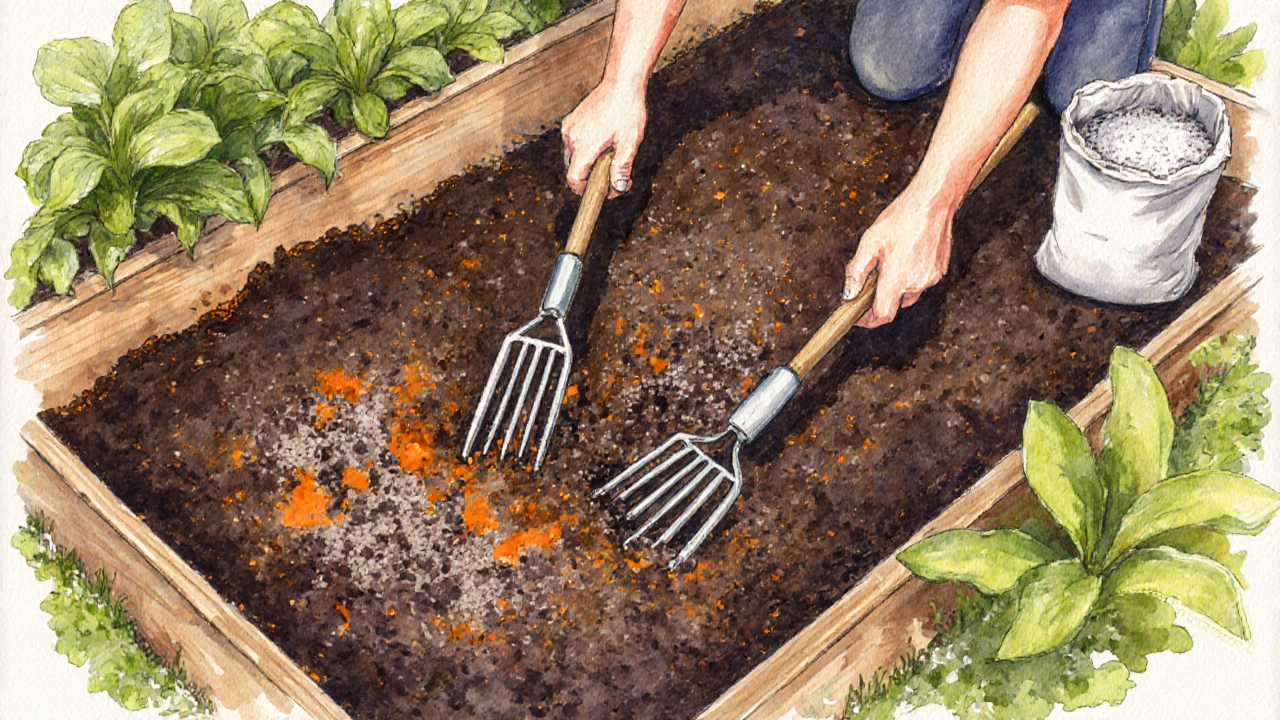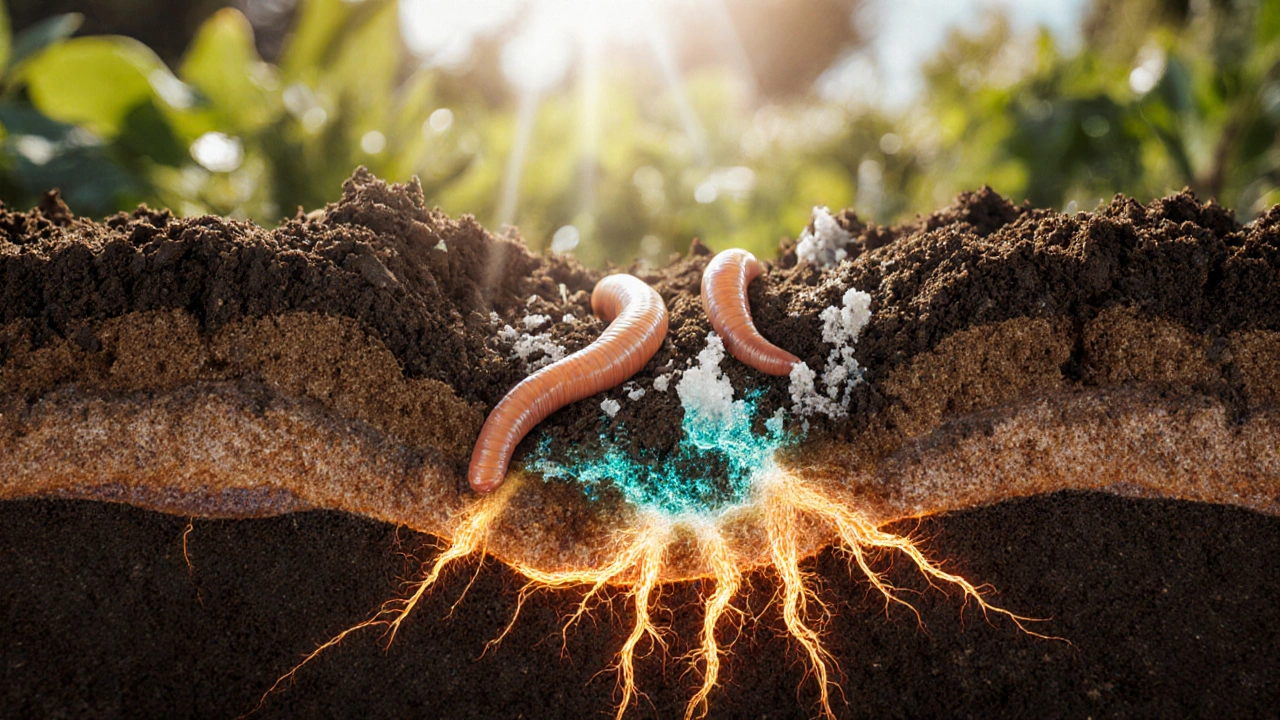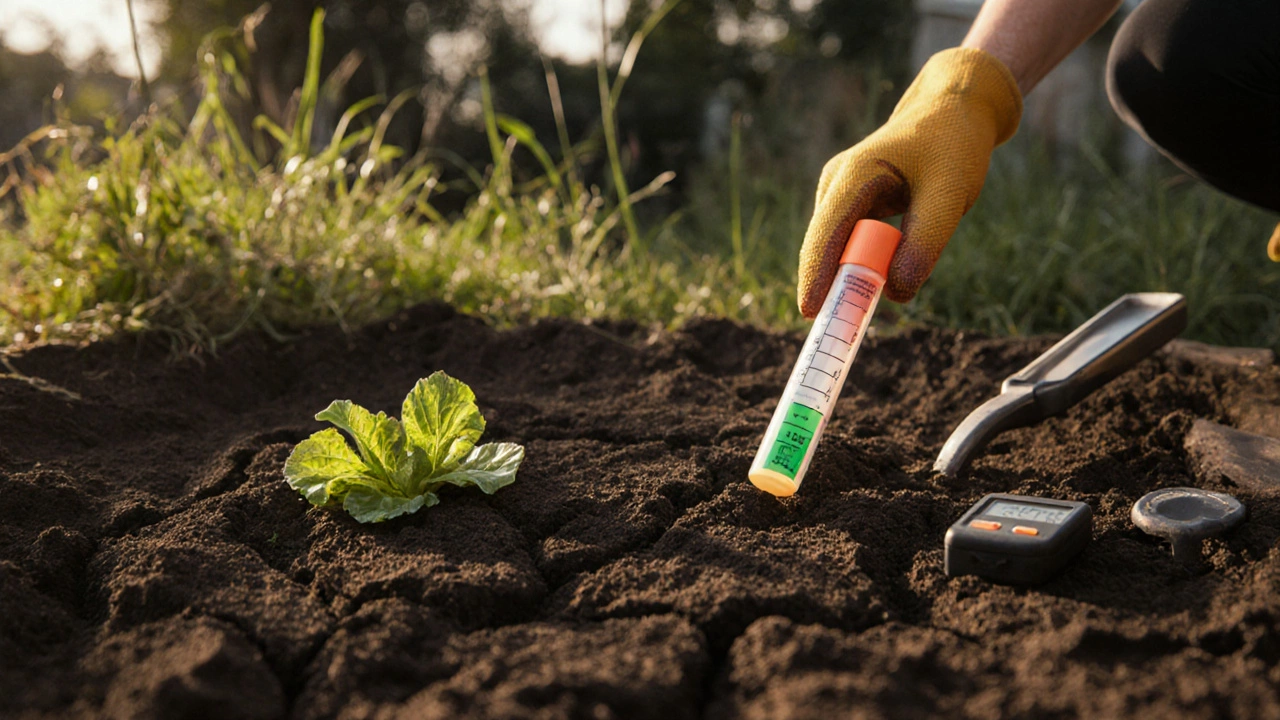Soil Amendment Calculator
Garden Soil Calculator
Recommended Application
Enter your garden details and select an amendment to calculate the recommended amount.
When your garden soil feels dense and lifeless, garden soil is the medium that supports root growth, holds water, and supplies nutrients often needs a boost.
Old beds that have been tilled year after year, or that have hosted the same crops repeatedly, can lose structure, organic matter, and beneficial microbes. The result is poor drainage, compaction, and a nutrient short‑fall that keeps plants from thriving.
- Test your soil before you act.
- Add organic matter to rebuild fertility.
- Improve texture with structural amendments.
- Balance pH so nutrients become available.
- Encourage soil life - earthworms, microbes, and mycorrhizae.
- Plan for ongoing maintenance, not a one‑off fix.
Step 1 - Diagnose the problem
A blind amendment often does more harm than good. Grab a simple soil test kit from your local garden centre or send a sample to an extension lab. Look for three core numbers:
- pH - tells you whether the soil is acidic, neutral, or alkaline.
- Organic matter % - an indicator of how much decomposed plant material is present.
- Essential nutrients - N, P, K and secondary nutrients like calcium and magnesium.
Write down the results. If the pH sits between 6.0 and 7.0, most vegetables are happy. Anything below 5.5 or above 7.5 will need correction.
Soil pH is the measure of acidity or alkalinity that determines nutrient availability.
Step 2 - Re‑introduce organic matter
Compost is decomposed yard waste and kitchen scraps that adds humus, improves water‑holding capacity, and feeds soil microbes. Spread a 2‑3inch layer over the beds and work it into the top 6‑8inches. For a 100sqft garden, that’s roughly 1-2 cubic yards of mature compost.
If you have access to well‑rotted manure (horse, cow, or sheep), mix it with compost in a 1:1 ratio. Manure adds nitrogen and beneficial microbes, but always let it age at least six months to avoid burning plants.
Organic matter is decomposed plant and animal residues that improve soil structure and nutrient holding capacity is the key driver of long‑term fertility.
Step 3 - Enhance structure with mineral amendments
Biochar is charcoal produced from plant material under low‑oxygen conditions, prized for its porous structure that traps water and nutrients. Incorporate 5-10lb per 100sqft. Over time, biochar becomes a home for beneficial microbes, slowly releasing nutrients.
For heavy clay soils, add coarse sand (river sand) at a rate of 1part sand to 4parts soil. This improves drainage and eases root penetration.
Peat moss or coconut coir work well in sandy soils. They increase water retention without creating a hardpan. Use 1cubic foot per 10sqft and mix thoroughly.
Step 4 - Balance soil pH
If the test shows acidity (pH<6.0), spread garden lime (calcitic limestone) at 5lb per 100sqft for each pH point you need to raise. For alkaline soils (pH>7.5), apply elemental sulfur at 2lb per 100sqft, or use iron sulfate for a quicker reaction.
Gypsum is calcium sulfate that improves soil structure without altering pH, especially useful in sodic or compacted clay. Apply 40lb per 1000sqft and work it in to break up clods.

Step 5 - Invite soil life back
Earthworms are the natural tillers that aerate soil, boost microbial activity, and create channels for water infiltration. Encourage them by adding a “worm cast” of shredded newspaper, coffee grounds, and a handful of compost each spring.
Plant cover crops like clover, rye, or vetch in the off‑season. Cover crops are fast‑growing plants that protect soil from erosion, add biomass, and fix nitrogen (especially legumes). Turn them under before they flower; the roots decompose, leaving a richer humus layer.
Mulching with straw, wood chips, or shredded leaves keeps the surface moist, suppresses weeds, and adds a slow‑release source of organic matter.
Step 6 - Build a maintenance routine
Soil health is a marathon, not a sprint. Keep a simple calendar:
- Early spring - test pH, add lime or sulfur as needed.
- Mid‑spring - side‑dress beds with compost and biochar.
- Summer - monitor water; add mulch if drying out.
- Fall - plant cover crops, incorporate leaf litter, and apply a final compost top‑dressing.
Repeatedly adding 1inch of compost each year can boost organic matter by 0.5% annually, restoring a depleted bed to a healthy 5% level within a decade.
Quick reference table
| Amendment | Primary benefit | Typical application rate |
|---|---|---|
| Compost | Increases organic matter, improves moisture retention | 2‑3in layer (≈1‑2cubicyd per 100sqft) |
| Biochar | Enhances nutrient holding, provides habitat for microbes | 5‑10lb per 100sqft |
| Gypsum | Improves structure of heavy clays without changing pH | 40lb per 1000sqft |
| Garden lime | Raises pH in acidic soils | 5lb per 100sqft per pH point |
| Elemental sulfur | Lowers pH in alkaline soils | 2lb per 100sqft per pH point |

Common pitfalls to avoid
- Over‑liming - raises pH too much and locks up micronutrients.
- Using fresh manure - can scorch seedlings and introduce weed seeds.
- Applying amendments only on the surface - they won’t affect root zones unless incorporated.
- Skipping the soil test - you may add nutrients the soil already has in excess.
Real‑world example
A community garden in Manchester struggled with compacted clay that yielded only half the expected lettuce heads. They followed the steps above: a soil test revealed pH5.8, organic matter 1.5%. They added 2inches of compost, 8lb of biochar, and 30lb of gypsum per 200sqft. After a single growing season, lettuce yields doubled, and earthworm counts rose from 5persqft to 25persqft.
Final thoughts
Reviving tired garden soil doesn't require a magic formula; it needs a combination of testing, organic inputs, structural tweaks, and the right amount of patience. By treating your soil like a living ecosystem, you’ll see healthier plants, better harvests, and a garden that feels much more rewarding.
Frequently Asked Questions
How often should I test my garden soil?
A basic pH and nutrient test every 2‑3years is enough for most home gardens. If you’re making big amendment changes, re‑test after one growing season.
Can I use coffee grounds as a soil amendment?
Yes, in moderation. Mix them into compost or sprinkle a thin layer (no more than 1cup per sqft). Too much can increase acidity.
Is sand a good amendment for clay soil?
Coarse river sand works, but you need a lot - about 30% of the soil volume. Adding only a little can make the mix worse by creating a cement‑like texture.
Do I need both lime and gypsum?
Use lime to raise pH. Use gypsum when your soil is already at the right pH but feels heavy or compacted. They address different issues.
What’s the fastest way to see results?
Incorporating a generous layer of mature compost and a handful of biochar gives the quickest boost in water retention and nutrient availability - you’ll notice healthier seedlings within a few weeks.
Ready to give your garden a fresh start? Start with a simple soil test and then revitalize garden soil using the steps above. Your plants will thank you.

